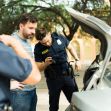The police arrested Marlon Flores for being in the wrong place at the wrong time. The California Supreme Court found that being in an area known for gang activity and ducking behind a parked car when police arrived were not sufficient indications of criminal activity to justify Flores’ detention by Los Angeles County Police officers.
One night in May 2019, Flores was in the Mariposa area of Los Angeles when he was spotted by Officers Daniel Guy and Michael Marino. Guy saw Flores standing along beside a red Nissan, and observed him as he moved behind the car and “ducked down.” Marino’s body camera recorded Flores behind the Nissan and showed the officers shining a flashlight on him. One of the officers told Flores to stand up, but he remained bent over. After about ten minutes, Marino told Flores to put his hands above his head and he handcuffed him.
At trial before Los Angeles Superior Court Judge Mildred Escobedo, Guy testified that Flores “acted suspiciously by attempting to conceal himself from police” and pretended to tie his shoe. Guy also said that he spotted “what looked like a drug pipe” in the Nissan. Guy then searched the car and found a dollar bill containing “suspected methamphetamine” and a gun in a backpack. Flores’s motion to suppress the evidence was denied because Escobedo found the suspect’s behavior to be “more than
enough …to find that there were articulable facts to find suspicion and enough for the officers to detain him, enough for the officers to thereafter question about identification.”
Flores then pleaded no contest to carrying a loaded firearm, while one count of armed possession of methamphetamine was dismissed. He was sentenced to three years of probation, 90 days in residential drug treatment and 90 days of outpatient care. Flores appealed to Division Eight of the Second District Court of Appeal, which confirmed Escobedo’s ruling in a divided opinion. The majority found that Flores was not detained until he was ordered to raise his arms so he could be handcuffed and said the police acted properly due to reasonable suspicion. They said “common sense” would find his ducking behind the car suspicious behavior.
Justice Maria E. Stratton disagreed in a dissent that would echo some of the cautions that the concurring opinion in the California Supreme Court would later put forth. Stratton said that Flores’s actions were “neither abnormal nor suspicious” given the “deep-seated mistrust certain communities feel toward police and how that mistrust manifests in the behavior of people interacting with them.” Flores appealed to the California Supreme Court.
In a unanimous 7-0 opinion authored by Justice Carol A. Corrigan, the district’s finding that stopping Flores was justified was reversed, and the case was returned to the trial court to allow Flores to withdraw his plea and for the court to grant his motion to suppress evidence. Justice Kelli Evans wrote a separate concurring opinion that was joined by four other justices.
Corrigan began the Supreme Court opinion by explaining that the Fourth Amendment permits “brief investigative stops when an officer has an objective basis for suspecting…criminal activity.” She elaborated that a “mere hunch” does not create reasonable suspicion,” but acknowledged that the level is “less than proof of wrongdoing,” and what “is necessary for probable cause.” With this in mind, she wrote that it was not necessary for the Court to determine exactly when the detention occurred because Flores’s presence and movements in a high crime area “did not provide a particularized and objective basis for suspecting that Flores was doing something illegal.”
She acknowledged that the manner (italics in original) in which Flores acted to avoid contact may be “considered by police officers,” and that the U.S. Supreme Court has said that “nervous, evasive behavior is a pertinent factor in determining reasonable suspicion,” as is “presence in an area of expected criminal activity.” But she discounted this reasoning in Flores’s case because “many law-abiding Californians live, work, or otherwise find themselves in areas where criminal activity is prevalent.” Corrigan also explained that “nervous, evasive behavior need not be ignored,” but the facts in this case did not measure up to what would be necessary to demonstrate reasonable suspicion.
Given all the facts, she went on to conclude that the total record “fails to support a reasonable suspicion that Flores was loitering for the purpose of committing a narcotics offense (as the officer suspected) or was otherwise engaged in “criminal activity.”
Corrigan said “mere presence” in a known narcotics area “does not tip the scales in favor of detention” and Flores was not observed either buying or selling drugs. Nor did he try to run away. The suspect did not even interact with anyone. Such actions would be relevant in determining whether a detention was justified. But none was present here and the facts differed from all cases upon which the Attorney General relied.
Corrigan said the officers could have continued to observe Flores for a longer period of time to see if actions that provided reasonable suspicion would actually occur. She also cautioned that “As a matter of precedent and as a matter of sound reason, the establishment of reasonable suspicion will always be contextual” as she reversed the Court of Appeal and remanded the case to the trial court so Flores could withdraw his no contest plea and his suppression motion could be granted.
The concurring opinion by Justice Evans agreed that Flores’s detention was unlawful but also cautioned future decision makers, as District Judge Stratton did, to view “attempts to avoid engaging with the police with care and caution” in cases “…where a suspect is under no obligation to respond to a police officer’s inquiry.” She pointed out that fear of contact with the police, “is based on the unfortunate and longstanding realities of policing in many minority communities across the country, as well as the police killings” of George Floyd and nearly 40 others whom she named in the opinion. She lamented that “it is still the case that communities of color disproportionately experience heightened levels of police scrutiny and racial profiling.”
Justice Corrigan concluded by cautioning, “While the evaluation of whether an individual’s behavior supports a finding of reasonable suspicion is an objective one, a test that fails to account for the realities of so many Californians would not be a reasonable one.”






